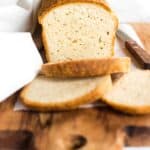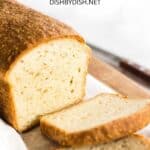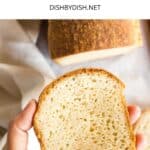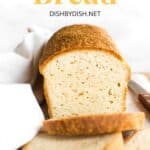Description
Incredibly soft and fluffy, this easy gluten-free potato bread is a great way to make use of leftover mashed potatoes. It’s perfect for making sandwiches, avocado toast, or eating as toast with jam. Totally dairy-free too, but no one would know! Go bake a loaf to enjoy homemade gluten-free bread today!
Ingredients
- 1 cup mashed potatoes
- 2 large eggs, beaten
- 1 cup warm water (between 105F to 115F)
- 1/4 cup sunflower oil
- 2 1/4 cups gluten-free all-purpose flour
- 1 teaspoon xanthan gum (omit if your flour blend already includes it)
- 2 tablespoons psyllium husk powder
- 2 1/4 teaspoons instant yeast
- 1 tablespoon sugar
- 1/4 teaspoon salt
Instructions
- Grease: Grease an 8″ x 4″ loaf pan with oil.
- Whisk Dry Ingredients: In a large bowl, sift the gluten-free all-purpose flour, xanthan gum (if using), psyllium husk powder, instant yeast, sugar and salt. Whisk well to combine.
- Blend: Process the mashed potatoes and eggs in a high-speed blender until you get a thick, creamy yellow mixture.
- Add Water and Oil: Transfer the mixture to a large mixing bowl. Add water and oil and mix well to get a pale yellow liquid.
- Form the Dough: Add the dry ingredients to the bowl with the wet ingredients and mix well until you get a homogeneous sticky dough (the dough will look shaggy and be rather wet, but that’s the texture you want).
- Transfer Dough to Pan: Transfer the dough to the prepared loaf pan and use a wet spatula to smooth out the top of the dough.
- Let Rise: Cover the pan with a kitchen towel and let the dough rise a warm, draft-free place for 40 to 50 minutes, until it has roughly doubled in size (I like to place the pan in the microwave with the microwave switched off).
- Preheat Oven: While the dough is rising, preheat the oven to 350F and place the rack in the center position.
- Bake Until Golden Brown: Bake for 1 hour until the top of the bread is golden brown the loaf sounds hollow when tapped.
- Let Cool Before Slicing: Allow the loaf to cool for 10 minutes in the pan, before removing and placing it on a wire rack to fully cool (at least 30 minutes) before slicing.
Notes
Mashed Potatoes: I like using leftover mashed potatoes, but you can also use fresh mashed potatoes or instant mashed potatoes if that’s what you have. If you like, you can also use mashed sweet potatoes if you prefer.
Eggs: Eggs help to bind the ingredients better and gives the loaf a better rise. If you are vegan or allergic to eggs, you may also use aquafaba or an egg-replacer.
Water: Make sure the warm water has a temperature of between 105F to 115F. If the water is too cold, the yeast will not get activated, but if the water is too hot, the high heat will kill the yeast. Alternatively, of you prefer, you may also use warm dairy-free milk (such as almond milk, cashew milk, tigernut milk, rice milk, coconut milk etc.). If you are not vegan or lactose-intolerant, feel free to use normal whole milk instead.
Oil: I like using sunflower oil because I always have a bottle of sunflower oil on hand. You may also use other types of vegetable oils such as olive oil, avocado oil, or even melted coconut oil or melted vegan butter. Alternatively, if you are not lactose-intolerant, feel free to use normal butter if you prefer.
Gluten-Free All-Purpose Flour: I recommend using a good-quality gluten-free all-purpose flour blend that includes lighter flours and starches (such as rice flour, tapioca starch, corn starch, potato starch) to ensure you get a light and fluffy final texture. I do NOT recommend using a blend with heavier flours (such as garbanzo bean flour) as that will result in a denser bread.
Xanthan Gum: Xanthan gum is the replacement for gluten in gluten-free flours, and helps the ingredients to better bind together. If your gluten-free flour blend does not already include it, make sure you add it in.
Psyllium Husk Powder: Psyllium husk powder is basically whole psyllium husks that have been ground into a super fine powder, and is a great binding agent that is essential in helping the bread have a beautiful dome once risen. If you only have access to whole psyllium husks, you can grind the whole husks into a powder. For best results, I do NOT recommend leaving it out or swapping it out for anything else.
Instant Yeast: I like using instant yeast because there’s not activation time required and you can mix it with all the other ingredients at the same time. However, if you don’t have instant yeast, you may use active dry yeast instead (just make sure you activate it with sugar and warm water before adding it to the other ingredients).
Sugar: I used granulated white sugar, but you may also use light brown sugar, dark brown sugar or coconut sugar if you prefer (just note that brown sugar or coconut sugar may cause the inside of the bread to be slighter darker in color). In this case, the sugar is food for the yeast, and is necessary for the yeast to feed on (and be activated) in order to produce the gases in the dough-rising process. Do not leave out the sugar (it will be consumed by the yeast and will not make the bread sweet).
Storing/Freezing: To store, place the cooled gluten-free mashed potato bread in an airtight container and place in the refrigerator for up to 5 days. To freeze, wrap the cooled loaf in plastic wrap and freeze for up to 3 months. Let frozen loaf thaw in the refrigerator overnight before slicing. Alternatively, you may also slice the bread before freezing so you can take out slices of the bread at a time and toast it immediately.
Adapted from: Serious Eats
- Prep Time: 10 mins
- Rising Time: 50 mins
- Cook Time: 1 hour
- Category: Bread
- Method: Baking
- Cuisine: American



